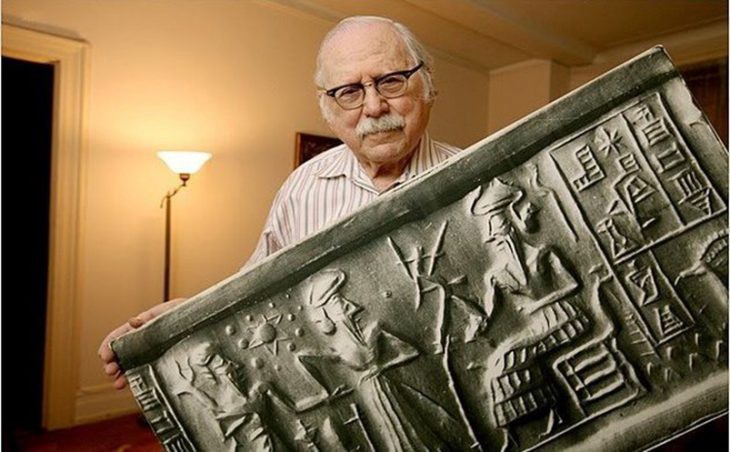The Anunnaki are described in ancient Sumerian writings as “those who fell from heaven,” a strong race of extraterrestrial beings that projected mankind hundreds of thousands of years ago.

The Anunnaki, or “those who descended from heaven,” were the major gods of Mesopotamia’s Sumerians, Akkadians, Assyrians, and Babylonians, who resided in what is now Iran and Iraq.

In the Epic of Atrahasis, the epic poem of Sumerian mythology that tells the story from creation to the Great Flood, Enki is responsible for the creation of mankind, which was destined to serve the gods.
Humans, who at this time had long lives, multiplied rapidly and Enlil, the head of the gods, was very disturbed by the noise humans made and decided to send catastrophes to Earth to shrink the population, and in each catastrophe, humans begged Enki to teach them what to do to survive.
Enlil then decides to unleash a vast flood to wipe away humanity once and for all, and because Enki was helpless to stop Enlil’s intentions, he went to Earth to save Atrahasis, whom he saw as a just man. Enki commanded and directed Atrahasis to construct an ark in order to preserve himself from Enlil’s wrath, and all other people were destroyed in the flood.
Following the deluge, Enlil proposed re-creating the human being, but with constraints such as being less prolific, shorter-lived, and more susceptible than the previous race.
Nibiru is a planet.
As he reveals in his book collection “The Chronicles of the Earth,” Azerbaijani writer Zecharia Sitchin presents a fundamentally different take on humanity’s beginnings.
 Anunnaki were classified as Ancient Astronauts by Zecharia Sitchin, and “those who came from heaven” were an extraterrestrial race of intellectually superior creatures who taught the Sumerians about astronomy, architecture, mathematics, medicine, metallurgy, and the written language.
Anunnaki were classified as Ancient Astronauts by Zecharia Sitchin, and “those who came from heaven” were an extraterrestrial race of intellectually superior creatures who taught the Sumerians about astronomy, architecture, mathematics, medicine, metallurgy, and the written language.
Sitchin believed that current Homo Sapiens were the result of genetic manipulation and that the Sumerians were created by combining a hominid’s DNA with their own.
Zecharia Sitchin, a specialist in ancient languages, begins a reworking of the Earth’s genesis myth based on the Babylonian epic Enuma Elish, acquired on cuneiform clay tablets from the Assyrian monarch Ashurbanipal library in Nineveh.
According to his view, Nibiru, the “Twelfth Planet,” has a long elliptical orbit around the Sun of 3,600 years and was inhabited by beings quite similar to us.
According to Sitchin, one of Nibiru’s two moons may have collided with Tiamat, an old planet between Mars and Jupiter that split in two and was flung into a new one millions of years ago. Orbit and one of Tiamat’s moons combined to produce the current planet Earth and its Moon.
Later, in another passage, the planet Nibiru would have collided with a residual shard of Tiamat, shattering it and forming the Asteroid Belt.

Following the terrible collapse and resolution of their planet’s issues, the Nibiruans went around the Solar System in pursuit of gold. Nibiru neared Earth’s orbit about 450,000 years ago, allowing some people to be delivered in spacecraft to our planet.
They created bases in ancient Mesopotamia and important gold reserves in southern Africa, where they discovered mines to harvest precious minerals. However, because the Nibiruan lords did not complete the mining activity, they delegated it to the Anunnaki people.
The Anunnaki were ten-foot-tall creatures with white skin, long hair, and a beard. Despite their physical and intellectual ability, they were treated as though they were slaves. As a result, the Anunnaki rebelled against their rulers and sought the creation of a lesser person to take their place.
The Nibiruans agreed to the proposition and decided to create a new species by merging their DNA with those of the most advanced monkeys on Earth.
Humanity’s Inception
Initially, Enki and Ninmah, the primary scientists, developed creatures of frightening power and huge size to labor for the Anunnaki’s in the mines; but, these new beings could not breed, so they had to be constantly generated to achieve ideal mineral extraction productivity.

Enki and Ninmah constructed various prototypes of creatures until they found one that could breed with each other, resulting in the creation of the first human species, Homo erectus.
When Nibiru migrated away from Earth, a portion of the “gods” returned to their home planet until the conclusion of the 3,600-year cycle, a period known as Sar to the Sumerians, while a portion of the Anunnaki stayed on Earth to supervise the gold mines and its new workforce.
However, the new humans created in the image and likeness of their creators began to have disagreements over worldly matters, forming alliances and revolting against their masters, just as the Anunnaki had done before.
Many of them were able to leave the mines and establish themselves as free individuals elsewhere on Earth, where they began a new but rudimentary way of life. After 3,600 years, the orbital cycle was finished again, Nibiru neared our planet, and the Anunnaki leaders returned to Earth, only to discover that the situation had deteriorated once again.
They punished the Anunnaki by forcing them to work in mines once more, and during their brief stay on Earth, they initiated fresh experiments to develop a new, more perfect race of laborers. Thus, the senior scientist Enki and the physician Ninti employed genetic modification and in vitro fertilisation to create a new species capable of thinking, speaking, breeding, and generating homo sapiens.
“He created man and woman, and he blessed them and named them Adam on the day they were made.” 5:2 (KJV).
As a result, the Hebrew title Adam does not refer to a single individual, but to the earliest group of humans known as Adamites, or “those of the earth.”
According to Sitchin, ancient records claim that these “gods” supervised Sumerian civilisation’s growth and that the human monarchy was established to act as a conduit between humans and the Anunnaki.
There was one important concern that remained after the birth of man. The other humanoid entities who had fled and dispersed were multiplying and spreading over the earth. The solution arrived in the shape of a gigantic flood caused by the instabilities that had been occurring in the Solar System for around 12,000 years.
The Anunnaki subsequently made the decision to evacuate the planet and abandon all of its inhabitants to the flood. Nonetheless, Enki, worried that his most recent Creation was too wonderful and unique, resolved to aid and preserve people by directing Atrahasis to build a gigantic ark in a scenario reminiscent of the biblical Noah.
Nibiru’s last visit, according to Zecharia Sitchin, was in 556 BC, and given its 3,600-year orbit, its return is predicted in the Third Millennium. He thinks, however, that the Anunnaki will arrive sooner, between 2090 and 2370, and that their arrival would coincide with the astronomical transition from the Age of Pisces to the Age of Aquarius.































